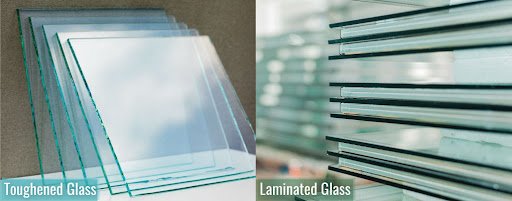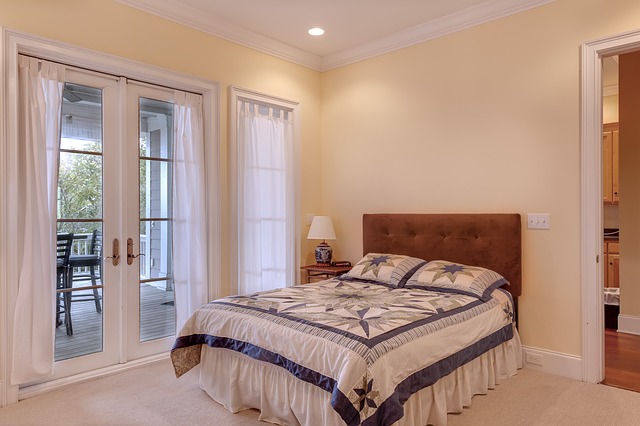Glass is emerging as the main building material for residential and commercial projects. Main doors, window walls, and whole building facades feature glass as the main material. Glass adds a unique allure to the structure. However, the security of the building becomes a concern. In order to ensure security without compromising on aesthetic brilliance, safety glass is used. Hence, there is an enormous rise in the demand for safety glass.
There are two main types of glass that are categorized under safety glass; tempered and laminated glass. We will explore laminated glass vs tempered glass in this blog to clarify the difference between the two.
Laminated Glass Vs Tempered Glass – The Showdown!

here are a number of characteristics that separate laminated from tempered glass. These traits serve as the defining factors for homeowners and commercial builders in choosing the glass type for their projects. Below are the primary elements that determine laminated glass vs tempered glass.
- Basic Structure And Manufacturing Technique
There is a clear difference between the manufacturing process of laminated and tempered glass.
Laminated glass is created by fusing two or more panes of glass together with an adhesive interlayer. This resinous layer holds the glass panes together and ensures that the layers of glass stay intact even on a very hard impact.
Whereas tempered glass has a single layer of glass in its basic construction. It is strengthened by heating the glass sheet to a very high temperature. The heating process is followed by supercooling. This comprehensive manufacturing process renders high strength value to the glass.
- Strength Analysis
Tempered glass is four times stronger than ordinary glass. It can be made even stronger with the repeated technique of tempering. It can take a hard impact without breaking.
Laminated glass is a potentially unbreakable glass type. The multi-pane glass structure is further reinforced by the adhesive interlayer. These solid builds render an exceptional structural strength to the laminated glass. It can even be used for bulletproofing purposes due to its high strength value
- Safety Value
Bothe tempered and laminated glass are classified as safety glass. First of all, it’s very hard to break the tempered or laminated glass. However, in an instance of breakage, tempered glass shatters into small harmless pieces instead of sharp injurious shards of glass. So even when broken, tempered glass is not harmful.
On the other hand, laminated glass panels stays intact even on the hardest of impacts. The interlayer holds the cracked glass panes in the frame. So there are very few chances of laminated glass falling off the frame.
Due to these properties, both laminated and tempered glass is perfectly safe for use.
- Cost Comparison
Laminated glass is usually pricier than tempered glass. The multi-pane structure and complexity of the manufacturing process justify the price of laminated glass.
Tempered glass also has to go through some extra steps as compared to the standard glass formation, so it costs more than regular glass. However, the durability and strength value make laminated and tempered glass a smart investment.
- Availability
Both laminated and tempered glass is manufactured by following a different set of steps. Tempered glass follows a relatively easier way of manufacturing while the production of laminated glass is more complex. Considering the manufacturing process requirements, laminated glass is harder to get as compared to tempered glass. Toughened glass is easily available in different sizes, shapes, and styles while laminated glass needs to be created on custom orders. This justifies the widespread use of tempered glass in our daily lives.
Applications
Both tempered and laminated glass find a lot of application in modern architecture. However, there are some places where tempered glass is preferred and vice versa. Let’s explore some common applications of these glass types.
Applications Of Tempered Glass
Tempered glass is a household name. It is mostly used in everyday applications.
- Glass doors and windows of residential and commercial places are typically made up of tempered glass.
- It is used in bathroom interiors. Shower enclosures are a product of tempered glass.
- Skylights, sunrooms, and stair railings are also made of tempered glass.
- Toughened glass is the preferred choice for kitchen counters, table tops, and backsplashes.
- It is used in office partitions and glass walls.
- Kitchen appliances like ovens and stoves use toughened glass for high–temperature operations.
Applications Of Laminated Glass
Laminated glass is mostly known for its high-security applications.
- It is used in automobile windshields and windows to ensure safety.
- Retail storefronts integrate laminated glass to prevent burglary and forced break-ins.
- It is used in high-profile buildings like government offices, banks, and jewelry stores to ensure security.
- Laminated glass is also a preferred glass type for windows and doors in areas that are prone to hurricanes, tornadoes, and other weather adversities.
- It is used in airports, recording studios, and hotels for its sound insulation properties.
Which One To Choose?
The above discussion sheds light on the main differences between tempered and laminated glass. However, it is to be noted that, regardless of the differences, both laminated and tempered glass is safety glass. Both of them are used for different purposes. In order to make the right choice, understand your project requirement, go through the properties of laminated and tempered glass and then pick the one that suits your project requirements better. You can also get help from professionals in this regard.






